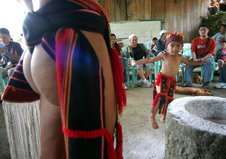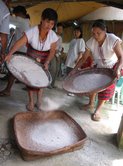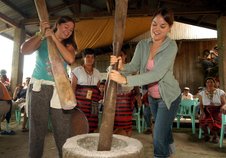Kiyyangan

What I wrote three years ago. The photos are the recent ones:
PRESIDENT Gloria Macapagal-Arroyo posed for photographers during her birthday in April last year, planting rice in Lubao, Pampanga, and used that for her 2003 calendar.
Ifugao Gov. Teodoro Baguilat Jr. also planted rice in a terrace in Barangay Julongan, Kiangan, Ifugao, last week but he had a nobler task on hand. He was doing this to save the rice terraces and essentially the whole province as well.
"I realized that I am not good at planting this," said Baguilat, who was doing it for the first time. "It looks staged but what can I do? I have to do this to revive the terraces."
Baguilat is reviving the 12 Ifugao rice rituals that have not been performed for decades. Last week's bolnat ritual, which is the third in the tunod or the Ifugao planting season, involved the mumbaki or the Ifugao holy men chanting for the seedlings not to wilt and grow vigorously.
The mumbaki also sacrificed four native chickens that the few guests ate with the traditional Ifugao fare like yam and bitter roots. Baya or rice wine was served liberally.
Only those in proper attire, g-string for men and tapis for women, were allowed to plant in the tumun-ak owned by the Dulinayans at the Julongan demonstration farm.
To perform the bolnat, Eleno Dulnuan, 83, of Nayon village, and Pedro Diplayu, 70, of Amduntog, both from Asipulo town, were brought to Kiangan to invoke the prayers.
Manuel Dulawan, cultural consultant of the Ifugao Rice Terraces and Cultural Heritage Office, said Dulnuan and Diplayu were among the few who can still recite the bolnat prayers.
Dulawan said the prayers of the mumbaki ensured that no pest would come to the seeds.
Three years ago, Diplayu was among the mumbaki who officiated in the patipat, a farming ritual last performed in 1944, in Amduntog where the men of the village wearing red g-strings and the crimson leaves of the dongla plant, danced at the edges of the terraces to drive away the evil spirits and rats.
There are 12 rites in the tungod, culminating with the ani or the festive harvest celebration where the mumbakol (the highest among the mumbaki) recites the rice myth. The ani is followed by the more somber upin and kahiw.
The provincial government is sponsoring all the rice rites in the hope of gaining interest in the rice terraces.
"We call on all Ifugaos to come home for a week in January up to June to plant and harvest. It may be a loss to them economically in their work but, culturally, it is a gain to them," Baguilat said.

Planting for fee
Tourists can also join in the planting instead of just viewing the terraces. "They can wear their g-strings and help in the revival of the terraces by planting for a fee. They will be more involved that way," Baguilat said.
The Ifugao rice terraces were declared World Heritage sites in 1995, but about a fourth of them in Ifugao had been abandoned. Baguilat said many terraces, particularly in Banaue where most of the tourists go, are also eroding.

"The erosion happened only in our generation. There are many causes, but I think new technology is not always the answer. These terraces have been here for centuries, but it is only now that they are eroding," Baguilat said.
Tourism is bringing in money, but tourism has harmed more than helped the terraces.
In Banaue, for example, woodcarving has destroyed the trees that served as watershed for the terraces. Many of the young men have also opted to be tourist guides rather than farmers.
The day before the bolnat, Baguilat had a meeting with United Nations Educational, Scientific and Cultural Organization (Unesco) representatives regarding ways on how to save the terraces.
"We have no mines, industrial zones and resorts. What have made Ifugao renowned are the rice terraces. Rice is our culture and our identity rests on them," he said.
The National Commission on Culture and the Arts granted Ifugao 200 million pesos for four years starting last month to restore and preserve the rice terraces and the culture surrounding them.
The Unesco wanted foreign experts and consultants to look into the erosion of the terraces.
"The state of physical erosion is the tangible effect. But more significant is the erosion of the social, political, cultural and environmental values that built the terraces," Baguilat said.
He said the Department of Agriculture had introduced new varieties of rice which disrupted the rice rites and weakened the solidarity of communities. He said Western religion had declared the rites to be idolatrous and slowly marginalized the mumbaki.
Dulawan established the Ifugao School of Living Traditions last year for the residents to learn lost art like baya making, gangsa playing, hudhud chanting for women, and baltung chanting for men.
The hudhud, which was estimated to have originated in the 7th century, is recited and chanted during the sowing and harvesting of rice, funeral wakes and other rituals. It takes three to four days to recite the whole 40 or so chapters of the hudhud.
The Unesco cited the hudhud in 2001 among the 19 oral and intangible heritages of the world.
But Baguilat said the school was attracting only the elders in the villages. "We want the young ones to continue the heritage," he said.
Rice rites
The Ifugao calendar of the 12 Ifugao rice rites started last December and is expected to end in June or July. Last month, the lukya, hipngat and panal rites were performed.

The lukya, which means opening, marked the start of the tung-od or the planting season of the Ifugaos. It was the first time that bundles of rice were taken out of the granaries and the mumbaki called on ancestral spirits to bless the rice so that even a small amount of the rice would be enough to fill the bellies.
The hipngat, which followed the cleaning of the terraces, was then performed to ensure that the rice in the granaries would not be destroyed.
In the panal, the seeds were prayed upon to all grow to maturity. After a day of idleness, the bundles of rice seeds known as binong-o were taken to the paddies and made to germinate.

The next ritual, the kulpi, is scheduled for Feb. 4 or 5 when the rice planting is over. It is performed from house to house in the village or even adjacent villages, and ends in the granary of the richest family or the kadangyan.
Each family contributes a chicken for the feat where the baltung or magical stories are performed.





0 Comments:
Post a Comment
<< Home